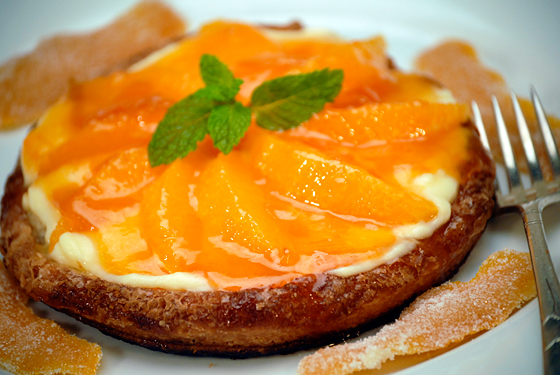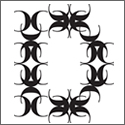Crystallized Puff Paste of Orange
Episode 115: All Puffed Up
Recipes: Crystallized Puff Paste of Orange (Puff Pastry Tartlets with Oranges and Cream), Puff Pastry, Fast Puff Pastry
Caramelized puff pastry rounds are covered with pastry cream and orange segments and finished with a glaze. The components can be prepared ahead, but the tartlets are at their best when assembled at the last moment.
Serves 8
PASTRY CREAM
1 cup milk
2 large egg yolks
3 tablespoons sugar
1 1/2 tablespoon cornstarch
1 teaspoon pure vanilla extract
4 tablespoons (1/2 stick) unsalted butter, softened
About 1 1/2 pounds Puff Pastry (see recipe below), Instant Puff Pastry (see recipe below), or store-bought puff pastry, preferably all-butter
6 tablespoons sugar
Egg wash made with 1 large egg, half the white removed, beaten
6–8 large navel oranges
GLAZE
1/2 cup peach preserves
1/2 cup orange marmalade
Fresh mint sprigs, for garnish
FOR THE PASTRY CREAM: Bring the milk to a boil in a medium saucepan.
Meanwhile, beat the egg yolks, sugar, cornstarch, and vanilla together in a bowl for about 30 seconds, until well mixed. Pour the milk into the egg yolk mixture while beating with a whisk, then return the mixture to the pan. Bring to a strong boil, stirring — especially around the edges of the pan — so the mixture doesn’t scorch as it thickens. Boil for 5 to 10 seconds. Pour into a bowl, cover with plastic wrap, and refrigerate until lukewarm.
Whisk the soft butter into the lukewarm pastry cream. Cover with plastic wrap pressed against the surface of the cream and refrigerate until cold. (The pastry cream can be made up to a day ahead.)
Roll the pastry out to a large rectangle, about 13 inches by 27 inches and 1/8 inch thick. Let it rest for a few minutes so it doesn’t shrink too much when cut. Using a lid or plate approximately 6 inches across, mark 8 rounds, and cut out the rounds.
Line two cookie sheets with nonstick baking mats or parchment paper and sprinkle each with 1 tablespoon of the sugar. Place 4 rounds on each sheet. Brush the pastry rounds with the egg wash and sprinkle 2 tablespoons of the remaining sugar on the 4 rounds on each tray. With the point of a knife, mark a circle inside each round approximately 3/4 inch from the edges.
Bake for about 15 minutes, until well cooked and crispy. If the rounds do not get brown enough, place under the broiler (not too close) for a few seconds. Cool on a rack.
Peel all the oranges with a sharp knife, moving the knife in a jigsaw motion so all the white pith is removed and the orange is completely nude. Working over a bowl, cut between the membranes on either side of each orange segment to remove the segments, letting them drop into the bowl. When all the flesh has been removed, squeeze the membranes over the bowl to release the remaining juice. Set the orange segments and juice aside.
At serving time, cut around the scored circle in each pastry round, and push the crystallized top down into the pastry to create a crisp, brown base. Spread 2 tablespoons of the pastry cream in the bottom of each pastry receptacle. Drain the orange segments and arrange on top of the pastry cream.
FOR THE GLAZE: Melt the peach preserves and orange marmalade together, and strain.
Coat the top of each pastry with 1 1/2 to 2 tablespoons of the glaze. Place on individual plates, decorate with sprigs of mint, and serve.
PUFF PASTRY
Makes 2 1/2 to 3 pounds
Puff pastry is one of the most difficult doughs to make; even for professionals, it has its pitfalls. It is always made with flour and butter in close to equal proportions, and the object is to keep the layers of butter enclosed between the dough layers, so as to achieve the proper flaky texture. The butter and the dough must be at the same temperature to roll uniformly. Soft butter will “squish” and run between the layers, destroying them; if the dough is too soft, it will do the same. The flour used to roll out the dough must be dusted off the surface of the dough before folding it, or the dough may become tough and dry. It is important to work quickly, but if the dough gets elastic, do not fight it; let it rest refrigerated for 30 minutes or so before continuing.
1 pound (about 3 cups) cold all-purpose flour
1/2 teaspoon salt
1–1 1/4 cups ice-cold water
1 pound very cold unsalted butter
Put the flour, salt, and 1 cup ice water in a food processor and process for about 10 seconds. If the dough is not holding together in a smooth paste, add up to 1/4 cup more water and process again for a few seconds, just until it gathers together.
Cut each stick of butter lengthwise into 3 slices. On a lightly floured surface, roll the dough into a rectangle about 20 by 9 inches. Turn the dough so a short end faces you. Starting at the top of the dough, arrange the butter slices touching each other in a single layer so they cover about two thirds of the dough, keeping the slices about 1 inch from the edges all around. Bring the lower third of the dough (not covered with butter) over half of the buttered dough. Fold the remaining third of buttered dough down over the top, creating a “sandwich” with 5 alternating layers of dough and butter. Press all along the sides to secure the butter inside.
Flour the work surface and gently roll the dough out, adding flour as needed, into a rectangle about 20 by 10 inches. Brush a little extra flour on the dough and bring each short end of the rectangle over so they join in the center. Press gently to seal, then fold the dough in half again, creating a 4-layer package; this is known as a double turn. Let rest, refrigerated, for 20 minutes or so.
Roll the dough again into a 20-by-10-inch rectangle and give it another double turn. Give the dough 2 more double turns (for a total of 4 double turns), letting it rest in the refrigerator between rolling if it gets too elastic.
Wrap the dough in plastic wrap and refrigerate. After it has rested for 1 hour, it is ready to be used.
The dough can be kept in the refrigerator for a few days or in the freezer for a couple of months. (If kept in the refrigerator too long, it has a tendency to become rubbery and difficult to roll out.) If you freeze it, be sure to defrost it under refrigeration before using. (If using only a piece of the dough, cut off the piece you need crosswise.)
FAST PUFF PASTRY
Makes about 2 1/2 pounds
Faster and easier than traditional puff pastry, this version is very good, though not quite as tender and flaky as the classic one. I often use it for wrapping fish or pâtés or as the crust for a tart. Instant flour makes the dough roll out easily. Be certain that the flour, butter, and water are all very cold.
1 pound (about 3 cups) all-purpose flour or instant flour, such as Wondra
14 ounces (3 1/2 sticks) very cold unsalted butter, cut into 1-inch pieces
1/2 teaspoon salt
1 cup ice-cold water, or a bit more as needed
Put the flour, butter, salt, and ice water in a large bowl and mix together with your hands for a few seconds, just enough to gather all ingredients into a ball. The butter should still be in large pieces. Alternatively, put the ingredients in a food processor and pulse a few times, just enough so the ingredients start to hold together. If need be, add up to a couple more tablespoons of ice water. Gather the dough into a ball. (Chunks of butter will still be visible throughout the dough.)
Sprinkle a board with flour. Press and roll the dough into a rectangle about 18 by 8 inches. Work as quickly as possible and be sure to have enough flour on the board so that the dough can slide and expand during the rolling. Sprinkle the dough with flour to coat all the visible pieces of butter, then brush the excess flour from the surface of the dough and give it a double turn (see the instructions for Puff Pastry above), then give it another double turn.
Allow the dough to rest, refrigerated, for 20 to 30 minutes, and then give one more double turn (a total of 3 double turns). Allow the dough to rest refrigerated for about 30 minutes before using.
Follow the same storing (and cutting) procedures as for the conventional puff pastry.
Copyright © 2011 by Jacques Pépin. Used by permission of Houghton Mifflin Harcourt. All rights reserved.












I love your show! I was looking for the recipe from show 105, for the Chocolate Mousse, and couldn’t find it? It looked wonderful, and as I love chocolate and have never made a mousse, I figured how could I go wrong. Could you send me to the site to get it?
Thanks you
Only the linked recipes are available online. Other episode recipes like the Chocolate Mousse are available by purchasing my book, Essential Pepin.
I always watch your shows but I missed the pastry dough one. Can you please tell me if I can use this dough for making croissants. I know that many croissant recipes call for yeast as one of the ingredients. Thank you
Hi, what’s the oven temperature for baking the puff pastry? Thanks!
I keep going back to the original episode that aired as episode 15 in 2012. The recipe there is slightly different. It adds sugar to the puff paste dough. I love your recipes from this episode and use them quite often. I especially liked the way you cut the top ring of the Paris Brest. That does alleviate any smashing of the pastry when slicing it. Such a helpful tip. Thank you so much for sharing your techniques and recipes. I have some of the first cookbooks that you came out with and was just looking through the Holiday cookbook from many years ago.
Merci Monsior Jacques!